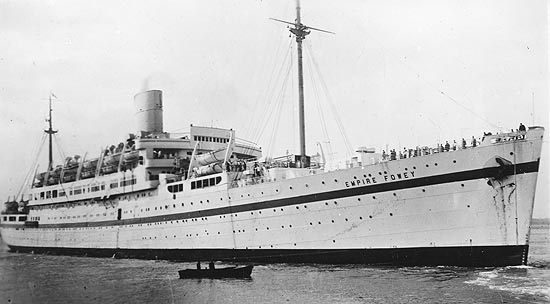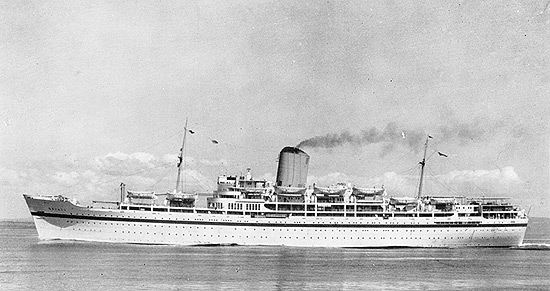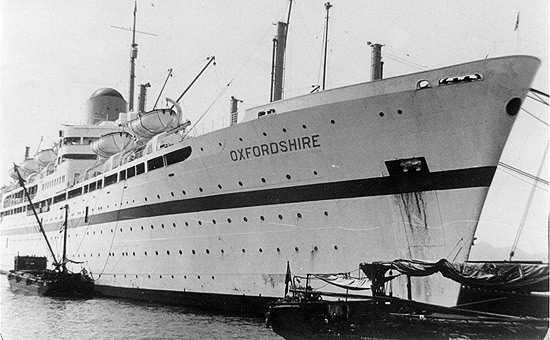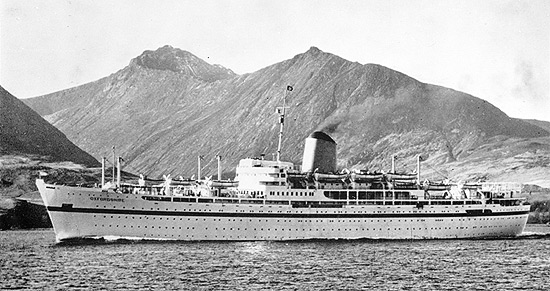Troopships and the Regiment
H M Transports after the Second World War
When peacetime trooping was resumed after the war, there were, as before the war, nine large permanent troopships and these were owned by Bibby, British India and the British Government, the four government owned ships being managed by Bibby, British India, the Orient Line and P & O. The nine ships comprised:
Devonshire (i) which survived the war was refitted in 1953 to carry 1139 passengers. In 1962 when trooping ended she was sold to British India and renamed Devonia. Broken up in 1967.
Empire Run. Royal Mail Line. Built in 1928 as the German Ubena with a gross tonnage of 9,523. She was managed for the Ministry of Transport as a trooper, having been declared a prize. She was a two-funnelled vessel and was broken up in 1957.
Empire Orwell, Orient Line. Built in 1936 as the German Pretoria with a gross tonnage of 17,362, she became a prize in 1945. She was a two-funnelled vessel and served as a trooper. After the 1939-45 War, she brought 1 Queen’s home from Singapore. The passage, round the Cape, took from 2nd March to 4th April 1957.

HMT Empire Orwell returns to Southampton with 1 Queen's abourd after their three year tour in Malaya.
Empire Pride. Bibby Line. Motor ship. Built in 1941 with a gross tonnage of 9,248. She was managed by Bibby for the Ministry of Transport. After serving as a trooper, she was sold to Greek interests in 1954.
Empire Test. Bibby Line. Built in 1922 with a gross tonnage of 9,380, she was managed by Bibby for the Ministry of Transport and sold in 1954.
Empire Windrush. New Zealand Shipping Co. Built in 1930 as the German Monte Rosa with a gross tonnage of 14,414, she was a two-funnelled vessel and became a prize in 1945. In 1954, off the North African coast, fire broke out in the engine room. She was taken in two but sank the following day. 1,500 Service personnel and crew were rescued, but four engineers lost their lives. On a previous voyage there had been an engine room fire when the ship had to put into Gibraltar for a week.
Highland Princess. Royal Mail Line. Motor ship. Built in 1929 with a gross tonnage of 14,133. She served as a trooper during and after the War. She brought 2 Queen’s home from Bombay to UK (19th January to 4th February 1947).
Karanja. P & O Line. Built in 1938 with a gross tonnage of 10,300. As an Infantry Landing Ship she carried 1 Surreys from Greenock to North Africa for the 1st Army landings in November 1942. She was sunk off Bougie a few days later.
Empire Clyde. Anchor Line. Built in 1921 with a gross tonnage of 16,280 and named Cameronia. She spent several periods as a troop transport from 1935. Renamed Empire Clyde in 1953. She was one of the largest troopships involved in the Normandy landings. Finally broken up in 1957.
Empire Fowey. Ex-Potsdam 1935. 17,518 tons, 17.5 knots. Norddeutscher Lloyd; surrendered as war reparations and transferred to Ministry of War Transport which renamed her Empire Fowey (1946). Refitted and given new engines and boilers between 1946 and 1949 and with a gross tonnage of 19,121, she was employed as troopship carrying 1,308 troops (1,642 all ranks and families) under P&O management until 1960. Early in this year she was laid up before being sold in May 1960 to the Pan-Islamic Steamship Company of Karachi which employed her as a pilgrim ship, renaming her Safina-e-Hujjaj. Broken up in 1976.

HMT Empire Fowey
Since the war substantial numbers of British servicemen have been stationed in continental Europe requiring the use of smaller short-sea vessels, including Vienna, 1929, 4,227 tons, 21 knots, MoWT/MoT (managed by LNER, later British Railways), converted into a permanent troopship with 1,048 berths in 1947, broken up 1960 and Empire Parkeston, ex-Prince-Henry, ex-North Star, 1930, 6893 tons 20 knots, MoT, broken up 1962.
H M Transports Nevasa (iii) of 1956 and Oxfordshire (ii) of 1957.
By 1951 it was recognized that the troopships then in service were ageing and would require replacement. During that year British India and Bibby each entered into an agreement with the British government to build a new troopship designed expressly for the carriage of officers and other ranks and their families with accommodation to the latest planned standards.The ships would be chartered to the British government for 15 years and the cost of building would be subsidized by the government.Each ship would be of approximately 20,000 tons and carry 500 cabin class passengers and 1,000 other ranks.The basic design was worked out by the Sea Transport Department of the Ministry of Transport with detail planning of each ship by her owner and the shipbuilder.
British India’s troopship Nevasa (iii) was built by Barclay, Curle & Co. She had a service speed of 18 knots. There were four full decks and she was fitted to accommodate 220 in 1st class, 110 in 2nd class, 69 non-commissioned officers and 931 troops, for a total passenger complement of 1,330.
Nevasa was launched on 30th November 1955 and completed on 12th July 1956.
It is noteworthy that, while the second Nevasa of 1913 of slightly over 9,000 tons was converted in 1925 to carry 1,000 troops, the tonnage of the third Nevasa, designed to carry a similar number of troops but built 30 years after the second ship’s conversion, was over 20,500 tons.
H M Transport Oxfordshire (1957-63). Bibby entrusted the building of their troopship Oxfordshire (ii) to Fairfield Shipbuilding & Engineering Co Ltd, also of Glasgow so both new troopers were Clyde built. As completed for duty as a permanent troopship, Oxfordshire accommodated 220 1st class, 100 2nd class, 180 3rd class and 1,000 troops, with a total of 1,500 passengers. With a crew of 409, her total complement was 1,909.
She was the first Bibby ship to be fitted with Denny Brown stabilizers. She had the British troopship’s traditional, and very attractive, livery of a white hull with a broad blue riband around it, red boot-topping, white super-structure and yellow funnel.
Oxfordshire was launched on 15th December 1955. Her completion was more leisurely than Nevasa’s and she did not run her trials until 29th January 1957. Delivered by Fairfields to Bibby on 14th February, she left Liverpool on 28th February 1957 on her maiden voyage via Dakar, Cape Town, Durban and Singapore to Hong Kong.
Nevasa and Oxfordshire were very similar ships and virtual half sisters. That their accommodation and layout represented a great improvement over the pre-war troopers is borne out by the ratio of tonnage to the number of troops carried, the tonnage of the new ships being much greater than their predecessors which carried roughly as many troops as the new ships. In the earlier ships the troops slept in hammocks, and in the new pair in beds with spring mattresses. Previously men had messed and slept in the same living space; now there were separate eating and dormitory areas and space provided for wet and dry canteens and cinema shows. According to Bibby, when the design of Oxfordshire was under discussion with the Ministry of Transport, the Ministry vetoed a suggestion that the ship be air-conditioned, citing the need for the troops to be tropicalised by the time they reached their destination!

HMT Nevsa 1957.

HMT Oxfordshire.

HMT Oxfordshire, Aden..
year between Britain and the Far East with calls at Port Said, Suez, Aden and Ceylon (Sri Lanka). In May 1958 Oxfordshire made her final sailing from Liverpool and Southampton became the only port for trooping. However, by now many of the colonies and dependences she had been intended to serve were gaining independence from Britain reducing the number of garrisons served by the dwindling number of British troopships and trooping by air was becoming an ever more viable alternative to trooping by sea. Nevasa and Oxfordshire had the misfortune of coming into service at a time when trooping commitments were waning and the reduction of numbers of troops requiring transportation was making trooping by air practicable and economic.
Transport by Air
By 1958 RAF Transport Command’s turboprop Bristol Britannia C1, with a maximum speed of 400 mph, a long-range cruising speed of 357 mph, a maximum range of 5,230 miles and a range with maximum payload of 4,310 miles, could carry 110 troops. During the period between two points, such aircraft could carry more troops over the same distance and, crucially, at a lower cost per soldier delivered. So Oxfordshire and Nevasa, the last and best British troopships ever built, became obsolete very soon after their maiden voyages, and their trooping careers lasted only five or six years. On 18th November 1962 Oxfordshirearrived at Southampton at the end of the last British trooping voyage from the Far East. In December 1962 Oxfordshire made her last round voyage as a troopship when she sailed from Southampton to Malta, which was soon to become independent. There she embarked 520 soldiers of The Royal Highland Fusiliers and 156 members of their families. After landing them at Southampton she went to the River Fal to join Nevasa in lay up, Nevasa having languished there since 13th October. In January 1963 Oxfordshire’s trooping contract was paid off and Bibby became free to dispose of the six year old ship. Oxfordshire was the last and largest Bibby trooper.
Special consideration had been given to the comfort of all passengers. Troops slept in three-tier bunks with mattresses instead of hammocks. With their clean modern lines, Oxfordshire and her near-sister Nevasa were among the most handsome ships in trooping service. Served as a trooper until 1964 when sold to the Fairstar Shipping Company. Subsequently used as a full-time cruise ship into the South Pacific from Sydney under the name of Fairstar. She carried 1 Queen’s Surreys from Aden to Hong Kong (19 February to 5 March 1962). This was the last trooper voyage of the Battalion.
Related
